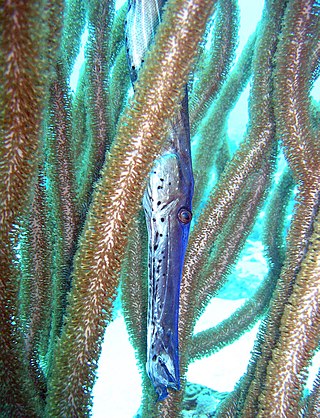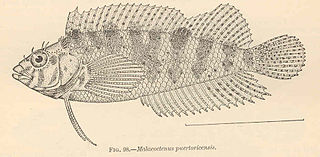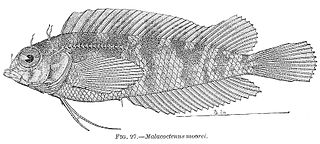
Labrisomids are small blennioids (blennies), percomorph marine fish belonging to the family Labrisomidae. Found mostly in the tropical Atlantic and Pacific Ocean, the family contains about 110 species in 15 genera.

Aulostomus maculatus, the West Atlantic trumpetfish, is a long-bodied fish with an upturned mouth. It often swims vertically while trying to blend with vertical coral, such as sea rods, sea pens, and pipe sponges.

Malacoctenus is a genus of labrisomid blennies native to the eastern Pacific Ocean and the Atlantic Ocean.

Malacoctenus boehlkei, the Diamond blenny, is a species of labrisomid blenny native to the central western Atlantic Ocean and the Caribbean Sea where it is an inhabitant of coral reefs at depths of from 5 to 70 metres. This species can reach a length of 6.4 centimetres (2.5 in) TL. The specific name honour the ichthyologist James E. Böhlke (1930-1982), of the Academy of Natural Sciences of Philadelphia.
Coralliozetus angelicus, the Angel blenny, is a species of chaenopsid blenny found in coral reefs from the Gulf of California to Acapulco, Mexico, in the eastern central Pacific ocean. It can reach a maximum length of 3.5 centimetres (1.4 in) TL. This species feeds primarily on zooplankton.
Stathmonotus lugubris, the Mexican worm blenny, is a species of chaenopsid blenny known from southern Mexico, in the eastern central Pacific ocean.
Dialommus fuscus, the Galápagos four-eyed blenny, is a species of labrisomid blenny endemic to the coasts of the Galapagos Islands. It inhabits the intertidal zone where it lives in tide pools as well as traveling on land. Special adaptations of the corneas of the eye and the gill filaments allow this species to travel up to 30 metres (98 ft) from the ocean in search of prey items such as insects and shore-dwelling crabs.
Labrisomus socorroensis, the Misspelled blenny, is a species of labrisomid blenny endemic to the Revillagigedo Islands where they inhabit rocky areas at depths of from extremely shallow waters to 10 metres (33 ft).
Malacoctenus aurolineatus, the Goldline blenny, is a species of labrisomid blenny native to the western Atlantic Ocean, including the Gulf of Mexico and the Caribbean Sea from southern Florida to northern South America. It inhabits rock and coral reefs at depths of from very shallow waters to about 5 metres (16 ft). It prefers living in the vicinity of sea urchins. This species can reach a length of 6 centimetres (2.4 in) TL.

Malacoctenus gilli, the dusky blenny, is a species of labrisomid blenny native to the Atlantic Ocean including the Gulf of Mexico and the Caribbean Sea from the Bahamas to the north coast of South America. This species inhabits reef patches, areas of sandy substrates with available rocks and beds of seagrass at depths of from 1 to 5 metres. It can reach a length of 7.6 centimetres (3.0 in) TL. The person honoured in the patronym of this species was not identified by Steindachner but it is most probably the American ichthyologist Theodore Nicholas Gill (1837-1914), the authority for the generic name Malacoctenus.
Malacoctenus delalandii is a species of labrisomid blenny native to the Atlantic Ocean and the Caribbean Sea from Guatemala to Brazil. This species is an inhabitant of coral reefs being found in sandy areas and around beds of the seagrass Thalassia testudinum. It can reach a length of 8.2 centimetres (3.2 in) TL. The specific name honours the French explorer and naturalist Pierre Antoine Delalande (1787-1823), who collected the type.

Malacoctenus ebisui, the Fishgod blenny, is a species of labrisomid blenny native to the Pacific coast of the Americas from the Gulf of California to Panama. This species can reach a length of 6.5 centimetres (2.6 in) TL. The specific name refers to Ebisu, a Japanese god of fishermen, as does the common name.
Malacoctenus gigas, the Sonora blenny, is a species of labrisomid blenny endemic to the Gulf of California. It is a shallow water species inhabiting patches of seaweed on reefs. This species can reach a length of 13 centimetres (5.1 in) TL.

Malacoctenus macropus, the Rosy blenny, is a species of labrisomid blenny native to the Atlantic Ocean including the Gulf of Mexico and the Caribbean Sea from southern Florida and the Bahamas to the northern coast of South America. This species inhabits a wide range of habitats including patch reefs, seagrass beds and sponge beds. It can be found at depths of from near the surface to 8 metres (26 ft) though it is more rarely found deeper than 2 metres (6.6 ft). This species can reach a length of 5.5 centimetres (2.2 in) TL. It can also be found in the aquarium trade.
Malacoctenus margaritae, the Margarita blenny, is a species of labrisomid blenny native to the Pacific coast of Central America from Costa Rica to Panama. This species can reach a length of 6.5 centimetres (2.6 in) TL.

Malacoctenus triangulatus, the saddled blenny, is a species of labrisomid blenny fish native to the Atlantic Ocean as well as the Gulf of Mexico and the Caribbean Sea from southern Florida to the coast of Brazil. It inhabits rocky shores and reefs at depths of from near the surface to 40 metres (130 ft) though most common shallower than 3 metres (9.8 ft). This species can reach a length of 7.5 centimetres (3.0 in) TL. It can also be found in the aquarium trade.
Malacoctenus versicolor, the Barfin blenny, is a species of labrisomid blenny native to the western Atlantic Ocean and the Caribbean Sea from southern Florida through the Antilles. It is an inhabitant of coral reefs preferring areas of rock or sand at depths of from near the surface to 7 metres (23 ft). This species can reach a length of 7.6 centimetres (3.0 in) TL.
Malacoctenus zacae, the Zaca blenny, is a species of labrisomid blenny native to the Pacific coast of Mexico from Baja California to Acapulco. This species can reach a length of 6.5 centimetres (2.6 in) TL.
Malacoctenus zonifer, the glossy blenny, is a species of labrisomid blenny native to the Pacific coast of Mexico from the south of the Gulf of California to Oaxaca. This species can reach a length of 8 centimetres (3.1 in) TL.
Malacoctenus zonogaster, the Belted blenny, is a species of labrisomid blenny mainly native to the Galápagos Islands. It is an inhabitant of tide pools and rocky shores being found from near the surface to 5 metres (16 ft). This species can reach a length of 8.5 centimetres (3.3 in) TL.








